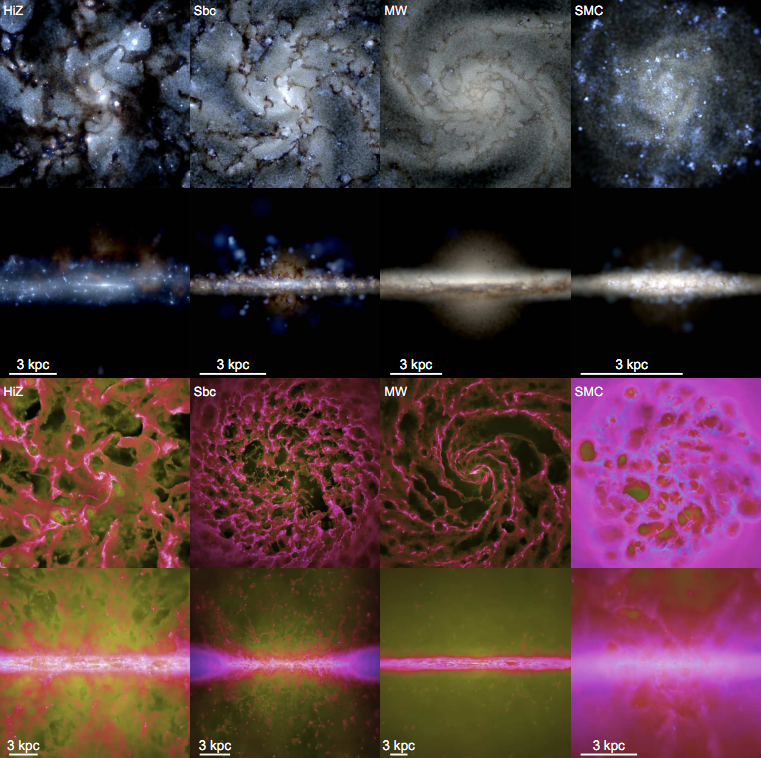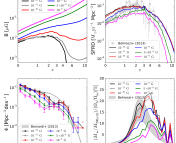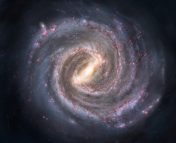Title: Dark matter halo shapes in the Auriga simulations
Authors: Jesus Prada, Jaime E. Forero-Romero, Robert J. J. Grand, Ruediger Pakmor, Volker Springel
First Author’s Institution: Departamento de Fisica, Universidad de los Andes, Bogota, Colombia
Status: Accepted for publication in MNRAS, open access on arXiv
Around 90% of the Milky Way’s mass is in the form of invisible dark matter. This makes it extremely difficult to determine the total mass or the shape of our galaxy.

But that certainly doesn’t stop astrophysicists from trying! A variety of creative methods have been devised to overcome the inability to see dark matter: the positions and the velocities of satellite galaxies can be used to estimate the mass of the Milky Way; the width of stellar streams can help determine the galaxy’s shape; even the very nature of dark matter can be deduced by studying the velocities of metal-poor stars.
All of these methods rely on the answers to a few fundamental questions: what do existing theories of dark matter predict about a galaxy’s gravitational potential? Can those theories produce galaxies that look like the Milky Way? Do the resulting potentials agree with the kinematics of observable tracers like satellite galaxies, stellar streams, and metal-poor stars? Simulations are the perfect tool for answering these questions.
Today’s authors are specifically interested in what simulations can tell us about the shape of our galaxy.
Baryons make things rounder
The main question in today’s paper revolves around how baryons influence the shape of dark matter halos. It may seem crazy to think that a baryonic component that is 10 times less massive than the dark matter halo could have any significant global effect, but it turns out that this is exactly what happens! The reason for this has a lot to do with phenomena that only exist when baryons are present, such as feedback from supernovae and Active Galactic Nuclei.
To make a fair comparison between dark matter halos with and without baryons, the authors took a set of simulated dark matter halos from the Auriga simulations and evolved them twice — once with just dark matter, and once with baryons as well. The second set of simulations includes full magnetohydrodynamics (a set of equations that governs movement of charged particles) in order to accurately capture the baryonic effects mentioned above.
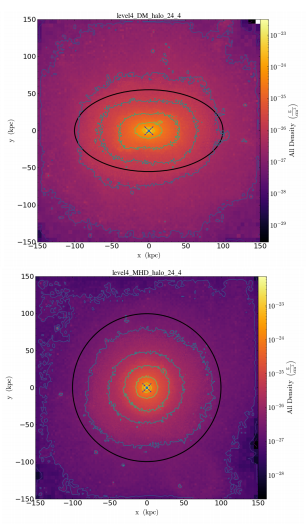
The most pronounced difference between the two sets of simulations relates to the shape of the evolved dark matter halos. In the dark matter only (DMO) simulations, a large fraction of the halos are triaxial, or ‘squashed’, with a large portion of prolate halos. Conversely, the same halos simulated with a baryonic component (labeled MHD for magnetohydrodynamics) evolve into more spherical objects. Figures 2 and 3 demonstrate the difference between the halo shapes in DMO and MHD.
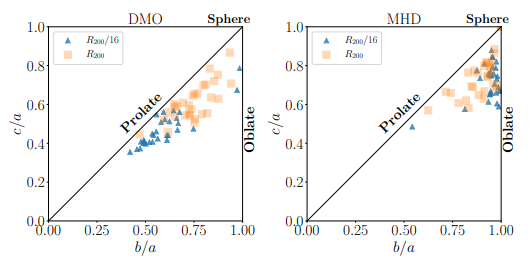
Galaxies with a twist
Another interesting effect that appeared in a few of the MHD simulations was a misalignment between the dark matter halo and the baryonic component. It is typically assumed that the stellar disk of a galaxy is aligned with the dark matter halo — and in the majority of simulations this assumption pans out. But in a few cases, particularly those with younger stellar components, the orientation of the halo changes significantly with radius, meaning the halos twist, sometimes by as much as 30 degrees.
The authors blame baryons for the twisting, because the effect is entirely absent in the DMO simulations. They point out that the correlation with age is in agreement with other research on the subject, but leave a full investigation to exactly why or how this twist happens to future work.
Can this relate to what is actually observed?
Yes! The authors conclude their paper by comparing their simulations to the shape of the Milky Way as determined observationally in two past works, one from 2010 (LM10) and one from 2016 (BBFK16). Both relied on the morphology of stellar streams to determine the shape of our galaxy. Figure 4 shows how these observational fits compare to the Auriga simulations. Specifically, BBFK16 is consistent with a subset of the Auriga simulations, while none of the simulated halos are consistent with LM10.
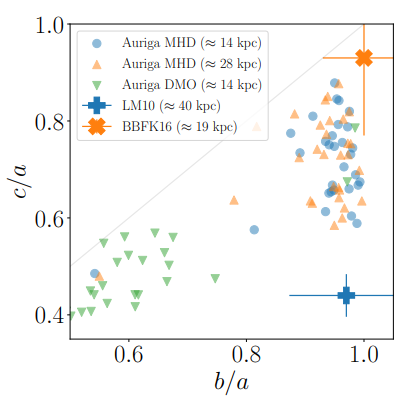
The simulations in today’s paper indicate that dark matter halos that host baryons should be spherical or mildly oblate, a conclusion that is in at least partial agreement with BBFK16. Prolate halos, it seems, will form only when there are no baryons around. So if you were holding out for a NyQuil-shaped galaxy, there may not be much visible matter for you to see there.

